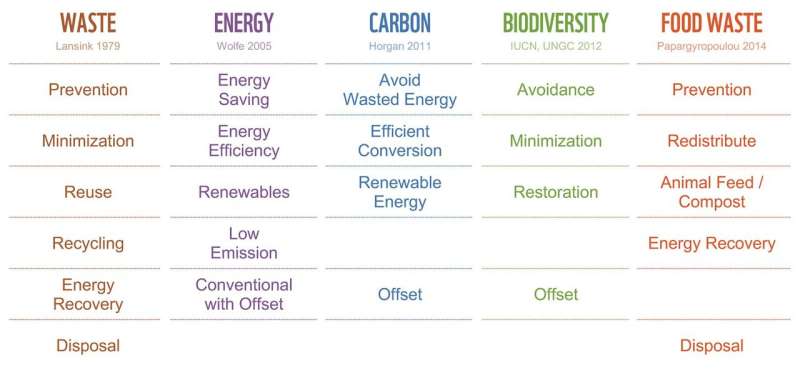A summary table of the multiple mitigation hierarchies discussed in this blog post with our interpretation of horizontal equivalencies. These are examples for further elaboration as pathways to action on climate and nature become more clear for non-state actors. Credit: WWF
Reflected in the number of companies setting science-based targets (SBTs) in line with climate science within the SBTI (Science-Based Targets Initiative), corporate climate progress has been striking, and we are seeing encouraging signs in the nature space as well (e.g., Fashion pact, Act4Nature, and OP2B, etc.). Key questions in corporate climate and nature actions are the necessity to reduce impact in line with scientific and societal need and the potential role of offsetting schemes in such action. This has led to significant discussion around so-called "mitigation hierarchies." Here, we provide a brief history of their evolution in natural resource management and highlight the increasing importance of adhering to the order they provide in facing some of the world's most pressing challenges. The temptation to skip to steps lower in the hierarchy that are easier or cheaper will at best provide a temporary bandaid to these complex global challenges and at worst, cannibalize efforts for meaningful change.
Mitigation hierarchies have been used for over a century in natural resource management and include prioritized steps that lead to the best outcomes for people and nature. These steps are generally Avoid, Reduce, Restore, Compensate/Offset,1 however adapted for the system to which they are applied. These hierarchies are inspired by Muir's Preservation theory (avoid/protect) and Pinchot's Conservation theory (reduce/compensate)—the basis of environmentalism in the United States and made manifest in the fact that many of our national parks, protected areas like Yellowstone or Yosemite or Shenandoah, are adjacent to or completely surrounded by national forests, managed for highest best use while sustaining impacts.
Later in the 20th century, as the focus of the environmental movement expanded beyond land, river, and wildlife management principles to addressing the ever-increasing impact or footprint of industrial activity–these same principles have been adapted to sustainable materials management. In 1979, Lansink's Ladder was introduced in the Dutch parliament as the first waste management hierarchy. This ladder or hierarchy included the steps of "Prevention: Reuse: Recycle: Recover: Dispose" and went on to become the basis for waste management the world over. Indeed, many readers will remember learning about "Reduce/Reuse/Recycle" as one of their first environmental lessons. In the early 2000s, strategies for renewable energy transitions took hold and hierarchies for renewable energy strategies were adopted and later food waste management hierarchies.
Compensation mechanisms (including offsets) are less featured in waste management frameworks and more prevalent in biodiversity/nature and climate action-frameworks. Building on mitigation offsets for wetlands and endangered species habitat, the biodiversity-conservation mitigation hierarchy was expanded in 2012 with a publication from UN Global Compact and IUCN presenting a corporate action framework at Rio +20 and the International Finance Corporation's Performance Standard 6 for clients to manage environmental and social risk (complemented by World Bank's standard updated in June 2019). While these guides focus at a project level, as we march toward the next set of globally agreed Convention on Biological Diversity goals (replacing the Aichi targets)—the focus of the discussions on "no net loss of ecosystem extent and condition" will force us to reconcile what implementing the mitigation hierarchy means at all scales: country, jurisdiction, project, and enterprise.
Within the climate debates, hierarchies have emerged through slightly different approaches. The concept of offsetting (or compensation) was first introduced in the Kyoto Protocol commitments for Annex I countries through the Joint Implementation and Clean Development Mechanism, two "flexible mechanisms" for developed countries to meet their emission reduction obligations under the Protocol. However, the Kyoto Protocol did not adequately incentivize developed countries to prioritize emission reductions over offsets. A step forward came in the introduction of the REDD+ program in 2005 under the United Nations Framework Convention on Climate Change (UNFCCC), which recognized the need to take action at the system scale, rather than small-scale forest offset projects, to tackle the drivers of deforestation and degradation.
The debate around reductions vs. compensation advanced further as climate science evolved and introduced the concept of large-scale "carbon dioxide removal" (CDR) in the IPCC's Fifth Assessment Report and further in the Special Report on 1.5C (SR1.5). At the same time, SR1.5 suggested an urgency for action to reduce emissions, reflecting that negative emissions at large scale were not likely to be achievable before 2040 and near-term emissions reductions must be steep (roughly halving global emissions by 2030).
Mitigation hierarchies and the order they bring are roadmaps to achieving the global goals and should guide societal and business plans. In the climate space, all of the desirable pathways within the IPCC models point to the need for fossil fuel emission reductions before carbon dioxide removal (from forests or technology). And the story is no different when we look to the IPBES global assessment on the state of biodiversity and ecosystem services. To continue to benefit from ecosystems—whether wood provisioning, disease regulation, or water filtration—we need to stop deforestation and habitat loss before we jump to "tree planting." Skipping over avoid and reduce to go straight to compensate is like submitting an extra credit project having turned in no previous assignments throughout the semester.
Every sector and every company has a role to play in supporting the pursuit of the global goals. Aligning corporate ambition with these international commitments is the measuring stick defining leadership, and mitigation hierarchies provide the roadmap to prioritize actions and timing. As companies develop their 2030 goals, prioritize avoid and reduce to align pathways with science and only then focus on "extra credit" compensation mechanisms.
Provided by WWF























